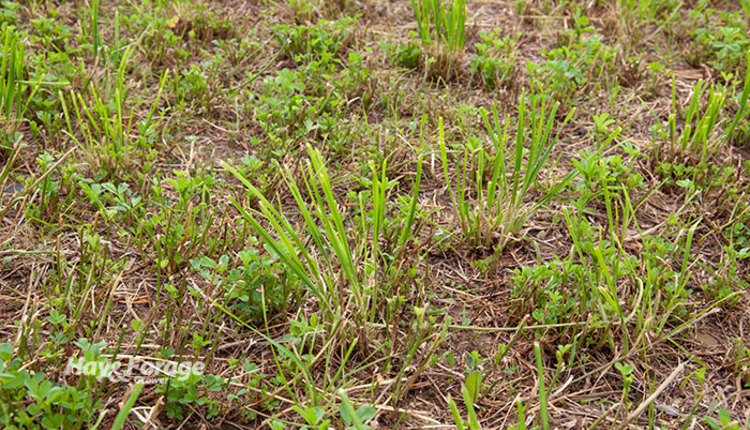Mixing it up on alfalfa-grass mixtures |
| By Mike Rankin, Managing Editor |
|
|
 No dairy farm looks the same. The same can be said for their perennial forage fields, most notably those with alfalfa. Some dairy producers prefer pure alfalfa stands, while others like to incorporate a little grass. In some situations, fields may be 50% or more grass. Based on where your ancestors decided to park the Conestoga wagon, it may be that soil type — rather than forage preference — dictates what the best alfalfa-grass combo should be. It’s common knowledge that grass fiber is more digestible than alfalfa fiber, which results in a higher neutral detergent fiber digestibility (NDFD) value at similar plant maturities. It’s this boost in fiber digestibility from grass that is appealing from a cow feeding perspective. But Barry Bradford, a professor of dairy management and nutrition at Michigan State University, offers some words of caution with this line of thinking. “There are agronomic and feed inventory reasons for growing grasses and legumes together, but mixing grasses with alfalfa as a shortcut to increase dry matter intake and milk production is a flawed strategy,” Bradford asserts. His reasoning is that the digestion processes for grasses versus legumes are different. Bradford explains that legumes pass through the rumen more rapidly than grasses. Even though the NDFD of a forage mix may be higher with the added grass component, it doesn’t necessarily mean that dry matter intake and milk production will improve. “Increasing the proportion of grasses slows passage rate, which will generally cancel out the benefit of increased NDFD on dry matter intake,” Bradford writes. “It is important to remember that when considering NDFD and its effects on milk yield and dry matter intake, we must only compare NDFD within forage type.” Field benefits and challenges “From a crop production perspective, there are advantages to growing alfalfa and grasses in mixtures,” notes Michigan State’s Kim Cassida. The extension forage specialist explains that planting alfalfa with a cool-season grass often results in greater total-forage yield than when each is grown separately. Alfalfa and grasses have different canopy and root structures, nutrient requirements, and microclimate preferences that minimize their competition with each other. Cassida cites an ongoing research trial at Michigan State where alfalfa was seeded with orchardgrass, tall fescue, or meadow fescue in a 50:50 mix. The mixture has boosted dry matter forage yields up to 83% compared to alfalfa alone. She notes that this could provide a huge benefit where the controlled land base is limited. In addition to the yield advantage of a mixture, Cassida notes other agronomic benefits: • Stand life is extended by adding grass either at seeding or two to three years into an alfalfa field’s life. • Alfalfa is less prone to be impacted by wheel traffic, root diseases, and insect pests when grown in grass mixtures. • Alfalfa-grass mixtures improve biodiversity, which benefits both above ground wildlife species and the proliferation of belowground microorganisms. • Alfalfa provides enough nitrogen to meet the grass component’s need, assuming that alfalfa comprises at least 30% of the stand. Cassida also points out that there are some challenges with alfalfa-grass mixtures. Dairy nutritionists are always looking for feed component consistency, which is generally lacking in mixtures. This is true even if the same seeding rates and proportions are used year-after-year. Environmental conditions at and after seeding largely dictate what the mix of alfalfa and grass will be in a given field. In addition to the variable results caused by the seeding and establishment environment, the proportion of grass to legume will vary within a field, from one cutting to the next, and from year-to-year. Older stands will have more grass. This proportional variability of alfalfa and grass dictates that frequent forage testing is needed to accurately formulate dairy rations. Producers will also need to document where forage from various cuttings and fields are stored. Finally, weed control is more challenging with alfalfa-grass mixtures. “While mixtures inherently provide some weed control by maximizing resource use, problematic weeds still sometimes get a foothold,” Cassida remarks. “When this happens, there are no easy herbicide options that will maintain both alfalfa and grass while killing the weed.” The forage specialist adds that the best strategy for weed control in an alfalfa-grass mixture is to mitigate weed issues before a field is seeded. Opinions and preferences for and against alfalfa-grass mixtures versus growing pure stands will continue to persist. That usually means there is no right or wrong answer, and the decision needs to be farm or field specific, depending on your goals, soil types, storage facilities, and the dairy herd’s nutritional needs. There are many outstanding dairy farms with high-producing cows on both sides of this fence. |
